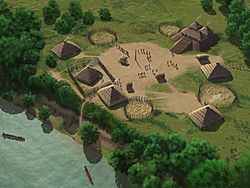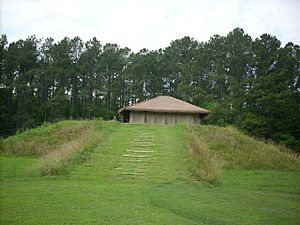Town Creek Indian Mound facts for kids

Artists conception of Town Creek Indian Mound during the late Town Creek-early Leak phases circa 1350 CE.
|
|
| Location | Mount Gilead, North Carolina, Montgomery County, North Carolina, |
|---|---|
| Region | Montgomery County, North Carolina |
| Coordinates | 35°10′58.1″N 79°55′46.1″W / 35.182806°N 79.929472°W |
| History | |
| Founded | 1150 CE |
| Abandoned | 1400 |
| Cultures | South Appalachian Mississippian culture |
| Site notes | |
| Excavation dates | 1937-1987 |
| Archaeologists | Joffre Coe |
| Architecture | |
| Architectural styles | platform mound, plaza |
| Architectural details | Number of temples: 1 |
|
Town Creek Indian Mound
|
|
| NRHP reference No. | 66000594 |
| Added to NRHP | October 15, 1966 |
Town Creek Indian Mound is an ancient Native American site in North Carolina. It's a special place where the Pee Dee people, a group from the Mississippian culture, once lived. They built a large platform mound and a village surrounded by a wooden fence.
The Pee Dee people lived here from about 1150 to 1400 CE. This site was very important for their ceremonies and community life. It's the only ceremonial mound and village from the Pee Dee culture found in North Carolina.
The Mississippian culture was known for building big earth mounds for spiritual and political reasons. The Pee Dee people traded with other groups across a wide area, from Georgia to Tennessee. Town Creek Indian Mound was named a National Historic Landmark in 1966. It's the only landmark in North Carolina that celebrates American Indian culture.
Today, the site is managed by the North Carolina Department of Natural and Cultural Resources. It helps us learn about the rich history of the Pee Dee people.
Contents
Life at Town Creek Mound
The Pee Dee people built their village on a small hill where Town Creek meets the Little River. This spot was a busy center for their homes, religious activities, and trading. Important discussions among different family groups, called clans, happened here.
Community and Ceremonies
Many important leaders and religious figures lived and were buried at Town Creek. The village was a place for big religious ceremonies and feasts. Clans from nearby areas would gather for special events, sometimes called "busks."
During these gatherings, people would clean and fix the temple, homes, and village grounds. They would also settle any disagreements or debts. Special purification ceremonies took place, which included fasting and bathing. The gathering ended with a big celebration called a poskito, where everyone feasted on new corn. This event is often known as the Green Corn Ceremony. People would take embers from the sacred fire back to their own villages, showing their unity.
Uncovering History: Archaeology at Town Creek
Archaeology is the study of human history through digging up old sites and artifacts. At Town Creek, this work has helped us understand the Pee Dee people, who didn't leave written records.
Early Discoveries
People in the area knew about the site before 1927, often finding arrowheads and other items. Unfortunately, some early digging by amateurs damaged parts of the site. Professional archaeologists began working there in 1937. This project was funded by the Works Progress Administration (WPA) during the Great Depression.
The land was owned by L. D. Frutchey, who allowed the University of North Carolina-Chapel Hill team to start their work. Mr. Frutchey later gave the mound and some land to North Carolina. The site was first called Frutchey State Park but changed to Town Creek in the 1940s. It was the first historic site in the state set up for visitors to learn from.
Joffre Coe and Major Finds
Joffre Coe was the main archaeologist at Town Creek, starting in 1937. He led the excavations for over 50 years, which is much longer than most archaeological projects. This long-term study helped him and his team learn a lot about the site.
Coe and his team found many artifacts and burial places. They also discovered the remains of a strong wooden fence, called a palisade, that once protected the village. Evidence shows this fence was rebuilt at least five times.
The Mound and Village Layout
Archaeologists found that the main mound was built over three different structures. First, there was a rectangular earth lodge that eventually collapsed. A temple was built on top of its remains. After that temple burned, another ceremonial building was constructed in the same spot. This final building had a ramp facing east, leading down to a flat, open area called a plaza.
The plaza was used for ceremonies and public meetings. Around the plaza, archaeologists found remains of other buildings, including a burial house. This burial house might have been important for a specific clan. The mound, burial houses, and many family homes were all inside the protective palisade. They even found two gates and guard towers in the palisade. This kind of protective wall was common at other Mississippian sites, like Cahokia in Illinois.
Burial Practices
Over 560 burials have been found at Town Creek Indian Mound. These are believed to be the remains of Pee Dee people. Some bodies were simply placed in graves. Others were buried fully stretched out, while some were re-buried as bundles of bones. Archaeologists also found young children and babies wrapped in deerskins and placed inside large pottery jars, which they call burial urns.
Visiting Town Creek Indian Mound
The state of North Carolina has created several facilities at Town Creek Indian Mound for visitors. You can explore a reconstructed ceremonial center. This includes the platform mound with a rebuilt temple on top. There's also a smaller temple and a mortuary (a building for preparing the dead).
Visitor Center and Trails
The visitor center has interesting exhibits and videos to help you learn more. There's also a gift shop. The visitor center, small temple, and mortuary are all accessible for people with disabilities.
Outside, you can walk on several trails and see outdoor monuments. There are also picnic tables if you want to bring a lunch.
Tours and Events
If you're part of a group, you can schedule a special tour in advance. These tours often include hands-on activities. Throughout the year, special events are held that focus on the daily life of the Pee Dee people. You can take self-guided tours of the rebuilt structures and the mound during normal operating hours. Admission to Town Creek Indian Mound is free!
See also





